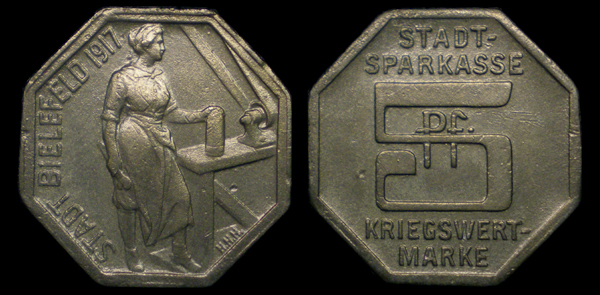
STADT BIELEFELD (GERMAN) 5 PFENNIG 1917
L- 40.1 City of Bielefeld (Westfalia) Zinc 5 Pfennig Coin
This coin was issued during the first world war by the German city of Bielefeld. On the obverse is a woman working in a munitions factory, a common sight in Germany during the war. On the reverse is the denomination and the inscriptions Stadtsparkasse (municipal savings bank) and Kriegswertmarke (war money token).
Bielefeld is a city of roughly 325,000 people in North Rhine-Westphalia, on both the western and eastern slopes of the Teutoburg Forest. Bielefeld is an urban district meaning it is one of the 116 cities that represent a district in their own right.
After its founding in 1214 by Count Hermann IV, the town grew into a fortified city known for producing fine linen. Administration of the city changed hands many times through the years until the Kingdom of Prussia gained possession of it after the conclusion of the Napoleonic Wars in the early 19th century. The railroad reached Bielefeld in the mid 19th century, with it came industrialization in the form of mills and metal works and a steady rise in population.
By World War I, Bielefeld had entered the war as a part of the German Empire. Bielefeld was an important industrial base helping to supply the German war effort. In the end, the city was not spared the attrition and economic turmoil that plagued Germany during and after the war.
After the war Bielefeld became one of the more prolific producers of notgeld. Often referred to as the 'City of Linen', Bielefeld issued an extensive and popular series of high denomination notes printed on silk, linen, and velvet during post war and hyperinflation. They also minted a variety of coins, some with strong political themes.
